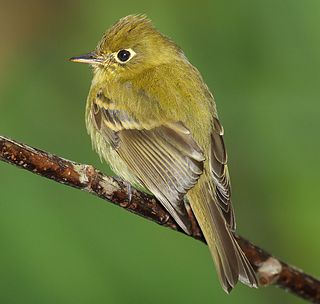
The tyrant flycatchers (Tyrannidae) are a family of passerine birds which occur throughout North and South America. They are considered the largest family of birds known to exist in the world, with more than 400 species. They are the most diverse avian family in every country in the Americas, except for the United States and Canada. The members vary greatly in shape, patterns, size and colors. Some tyrant flycatchers may superficially resemble the Old World flycatchers, which they are named after but are not closely related to. They are members of suborder Tyranni (suboscines), which do not have the sophisticated vocal capabilities of most other songbirds.

Myiozetetes is a small genus of passerine birds in the tyrant flycatcher family. The four species occur in tropical Central and South America.
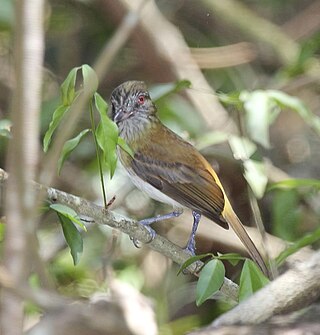
The bright-rumped attila or polymorphic attila is a small passerine bird in the tyrant flycatcher family (Tyrannidae). It breeds from northwestern Mexico to western Ecuador, Bolivia and southeastern Brazil, and on Trinidad.

The ground tyrants (Muscisaxicola) are a genus of passerine birds belonging to the tyrant flycatcher family Tyrannidae. There are about 13 different species. They are ground-dwelling birds which inhabit open country in South America, particularly the Andes and Patagonia. Several southern species are migratory, moving northward for the winter. Ground tyrants feed on insects and other invertebrates, mainly by picking them from the ground.
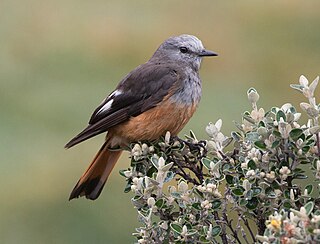
The red-rumped bush tyrant is a species of bird in the family Tyrannidae. It is found in Bolivia, Colombia, Ecuador, and Peru. Its natural habitats are subtropical or tropical moist montane forests and subtropical or tropical high-altitude grassland.

The many-colored rush tyrant or many-coloured rush tyrant is a small passerine bird of South America belonging to the tyrant flycatcher family, Tyrannidae. It is the only member of the genus Tachuris and is sometimes placed in a separate monotypic family. It inhabits marshland and reedbeds around lakes and rivers. It is particularly associated with stands of Scirpus. The nest is built among plant stems.

The cliff flycatcher is a species of bird in the tyrant flycatcher family, Tyrannidae. The cliff flycatcher is the only species in the genus Hirundinea after the swallow flycatcher was merged, becoming subspecies Hirundinea ferruginea bellicosa. It is native to South America, where its natural habitats are cliffs and crags in the vicinity of subtropical or tropical dry forest, subtropical or tropical moist lowland forest, subtropical or tropical moist montane forest, and heavily degraded former forest.

The spectacled tyrant is a species of bird in the tyrant flycatcher family Tyrannidae. It is the only species placed in the genus Hymenops.

The fire-eyed diucon is a passerine bird of South America belonging to the tyrant flycatcher family Tyrannidae. It is the only species placed in the genus Pyrope.

The little ground tyrant is a species of bird in the family Tyrannidae, the tyrant flycatchers and is the only species placed in the genus Syrtidicola. It is found in Amazonian Brazil, Peru, and Bolivia; also smaller regions of Colombia and Ecuador. Its natural habitats are subtropical or tropical moist shrubland and rivers.

Myiotheretes is a genus of South American birds in the tyrant flycatcher family Tyrannidae. These superficially thrush-like birds are large tyrants of the Andean highlands. The red-rumped bush tyrant is considered closely related.

Neoxolmis is a genus of South American birds in the tyrant flycatcher family Tyrannidae.

Poecilotriccus is a genus of small flycatchers in the family Tyrannidae. Except for the recently described Johnson's tody-flycatcher, all have, at one point or another, been included in the genus Todirostrum. Some species have been known as tody-tyrants instead of tody-flycatchers. Most species are found in South America, but a single species, the slate-headed tody-flycatcher, is also found in Central America. The black-chested tyrant may also belong in this genus, but most place it in the monotypic genus Taeniotriccus.
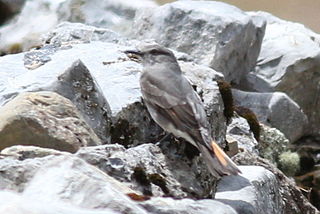
The rufous-webbed bush tyrant is a species of bird in the family Tyrannidae. It is found mostly in Argentina, Bolivia, and Peru with a few records in Chile, where its natural habitats are subtropical or tropical moist montane forests and subtropical or tropical high-altitude shrubland.

The grey monjita is a species of bird in the family Tyrannidae that is the only member of the genus Nengetus. It is found in Argentina, Bolivia, Brazil, Paraguay, Peru, Suriname, and Uruguay. Its natural habitats are dry savanna, subtropical or tropical seasonally wet or flooded lowland grassland, and pastureland.

The black-crowned monjita is a species of bird in the family Tyrannidae. It is found in Argentina, Bolivia, Brazil, Paraguay, and Uruguay. Its natural habitat is subtropical or tropical dry shrubland.
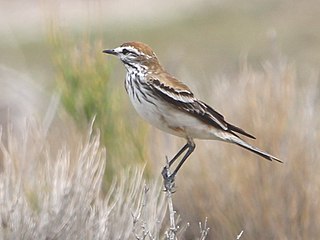
The rusty-backed monjita is a species of bird in the family Tyrannidae. It is endemic to Argentina. Its natural habitats are subtropical or tropical dry shrubland and pastureland.
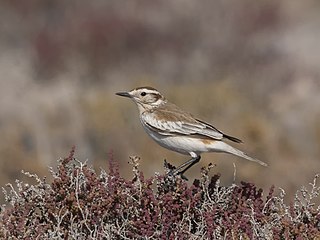
The Salinas monjita is a species of bird in the tyrant flycatchers family Tyrannidae which is endemic to Argentina. It is threatened by habitat loss.

The suiriri flycatcher is a species of bird in the family Tyrannidae found in semi-open habitats in South America. It was formerly split into two species; the Chaco suiriri and the Campo suiriri. Suiriri originates from Guaraní, where it is a generic name used for several medium-sized tyrant flycatchers.
The bush tyrants are found in the following places:



















